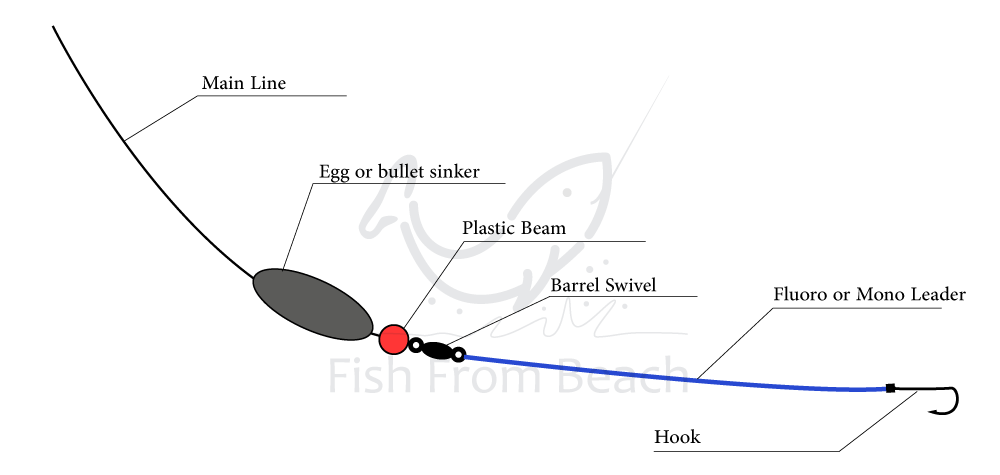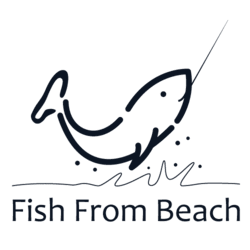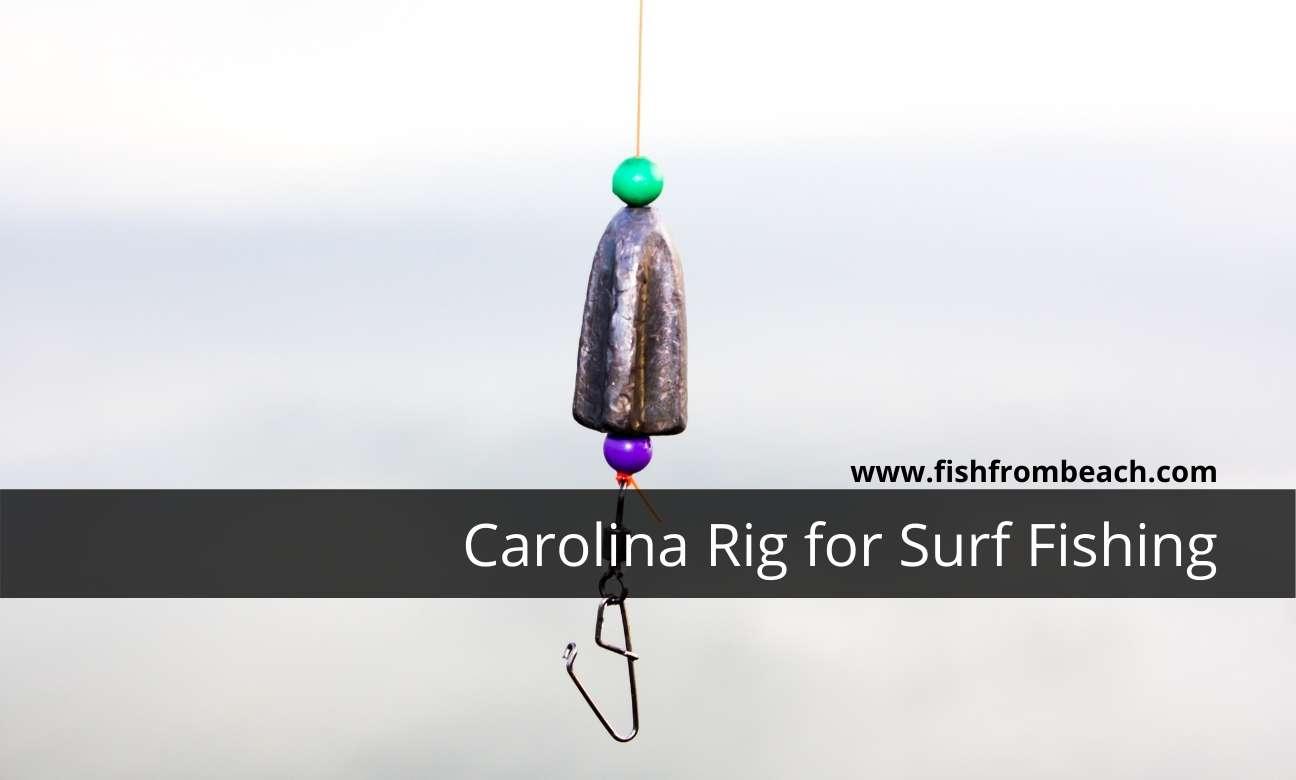The Carolina rig is one of the most popular line setups for surf fishing.
Despite being originally a freshwater rig dedicated to bass fishing, the Carolina rig (also known as the C-Rig) has proved to be a successful configuration for saltwater too, due to its simplicity and very rewarding bait presentation.
Many novice surf anglers ask what rigs to try when just starting to fish the surf and when they don’t have enough knowledge and experience to choose the right tackle for particular fishing situations ?
The simple answer to this is : rigs that are easy to set up, yet very effective at attracting fish and drawing bites no matter the weather and surf conditions. And guess what ? One of these rigs is the Carolina rig.
In this article, we will learn what is the Carolina rig from a surf fishing perspective ? How to set it up ? What makes it great for shore fishing ? and also some tips and best practices when using the C-Rig in the surf. So keep reading 🙂
What is a Carolina rig for surf fishing ?
The Carolina rig is a fishing rig used since the ’70s to target bass and the other bottom-feeding fish in lakes and rivers.
The special thing about this rig is how it separates between the sinker and the bait giving a natural look to the offering and increasing the bites count.
And despite being originally invented for freshwater fishing, the Carolina rig has become more and more popular among saltwater fishermen, particularly surf and kayak anglers.
What makes the C-Rig effective for saltwater is the way it presents the bait and how it makes it move deliciously just a few inches of the bottom where many predatory fish look for food.
This proved to result in more bites and catches when the other saltwater rigs failed to attract bottom-feeding fish. It also showed a better hookup ratio when the weather and surf conditions force fish to hold deeper in the surf zone.
On top of that, the Carolina rig is so easy to make and requires just 5 key elements :
- An Egg or bullet sinker
- A glass or plastic bead
- A Barrel swivel
- A Leader
- A Hook
With just that, you can have a successful line setup that continuously catches fish from shore.
Simply thread the sinker and bead into your main fishing line then use a Palomar knot to attach a barrel swivel to the line. On the other end of the swivel use another Palomar knot to add a leader and at the end of the leader attach a circle or bait holder hook.

As you can see, this is an easy line configuration that should not take more than 5 minutes of your time to set up.
In the next paragraphs, we will dive into more detail and discuss the best practices and recommendations for every component of this rig.
The sinker
Use as much weight you need to remain stable in the surf zone. As a rule of thumb, 3-4 ounces work well for most surf situations, but you may need more or less than that depending on the current and wind strength.
Bullet sinkers are the most common for the Carolina rig, but I personally prefer the egg-shaped sinkers because I believe they get snagged less often and perform better in rocky structures.
Some fishermen recommend the tungsten over lead for the C-Rig because it is denser for a given size and also more sensitive. They may be right, but I’m happy with lead and will keep it.
Moreover, tungsten is much more expensive than lead and you can lose so much money throwing it into the surf, especially in rocky structures.

The leader
Monofilament and fluorocarbon between 15 and 20 lb test are the most popular options here.
I prefer fluoro for the low visibility in the water and the better abrasion resistance. That said, mono has also produced great results for me.
What is more important about the leader is the length.
You need the leader to be long enough to cover a good surface but not that long so the bait floats too shallow or so far from the bottom.
As a rule of thumb, leaders should be from 12 inches up to 36 inches. Pick your optimal length depending on the tide, the depth of the surf, the targeted species, the current, the underwater structure…etc.
For instance, when I target the flounder or any other flatfish from shore, I keep my leader short (10-12 inches) to prevent other fish from stealing the bait, but when much kelp and weed are in the surf, I make sure my leader is longer than the grass so my bait stays visible to fish.
Related : Learn how to catch flounder from shore.
The hook
The hook should match the size of your bait, not the size of the fish you are trying to catch.
You want your bait to look good but also stay longer on the hook.
The use of too large or too small hooks increases the risk of losing the bait during the flight, and even if you successfully make it to the water, it would be easier for fish to steal your offering and escape the trap.
Consequently, for the Carolina rig, I use hooks ranging from 2/0 to 5/0 because that’s what works fine for the bait I use.
For the shape, I prefer circle hooks because, as I will mention later, the Carolina rig makes it a little bit difficult to detect bites, so I use circles as fish usually hookset themselves when they bite on them.
I had also a lot of success with octopus and bait holders hooks, but circles are always the first option I think off when fishing the surf.
Below* is a box of 150 good circle hooks of different sizes.
Circle hooks for surf fishing
Very strong hooks. Fish hookset themselves automatically as soon as they hit the bait, and I don't need to perform any move from my end. Also, the hooks only pierce the corner of the mouth and rarely hurts the fish guts and vital organs. Very helpful for catch and release.
Brand : UCEC
The main line
For the main line, use whatever serves best for your surf fishing conditions.
15-20 lb test mono or 30-50 lb test braid are standard picks here.
Personally, I use braid for the lack of stretch and the higher sensitivity and bite detection.
Read this for more about the optimal line weight for surf fishing.
The bead
The bead is necessary for the C-Rig because it protects the knot connecting the main line to the barrel swivel. Without it, the sliding sinker will keep beating up the knot weakening it up and creating a vulnerable spot in your configuration.
People use glass and plastic beads for the surf fishing Carolina rig but I prefer plastic.
Plastic is more durable and produces less noise when hit by the sinker. Yes, a little noise is healthy and may increase bites, but too much can spook fish and push them away.
The size of the bead depends on the knot. You want the bead’s hole to go over the knot for maximum protection.
I use 4 mm red plastic beads for my C-Rigs and they work just fine.
What makes the Carolina rig great for surf fishing ?
It keeps the bait at the bottom
When fishing the surf, you will probably want to stay all the time on the bottom because that’s where interesting things start to happen.
Species like the flounder, the snapper, the bream, and the redfish are all bottom-feeding fish. Getting them requires, therefore, keeping the bait close to the bottom and avoid the surface.
The Carolina rig allows doing exactly that because no matter how deep the surf zone is, the sinker will spool out your reel and pull your line as much as needed to reach the seabed.
That being said, when you cast the Carolina rig into the surf, make sure you free the line and let it go as far as it should. Once you feel the weight hitting the ground, take the slack out of your line and be ready to hookset any bitting fish.
It gives a natural look to your baits
The Carolina rig goes beyond taking the bait to the bottom and makes it also look more natural and appealing to fish, which helps to have more bites.
Once on the seabed, the leader starts to freely float in a circular path mimicking the movement of a wounded baitfish or a live shrimp or minnow.
This encourages more predators to attack the bait as it looks similar to what they eat on a normal day.
It covers more ground
The circular movement of the leader allows you to cover more spots maximizing your chances of hooking into something.
Many species that live nearshore are opportunistic feeders. What does this mean ? It means that, unless they are super hungry, they will stay in limited territories and wait for prey to swim their way. Targeting these species requires, therefore, moving around the beach and trying multiple spots to see which one brings bites.
The Carolina rig reduces the need to do so because the leader will do the work for you and cover wider zones in the surf.
It is easy to use
As seen earlier, the Carolina rig does not require much stuff and equipment to set it up. Just a sinker, a leader, a bead, a swivel, and a hook and you are ready to go.
This makes the C-Rig a great choice for beginners and kids, and also for those of us who can only fish the surf for a limited amount of time and don’t want to wast hours setting complicated surf fishing rigs.
It casts far and resists against the current
When it comes to surf fishing rigs, it is agreed that less is more.
The more things you attach to your terminal tackle, the higher the pressure you receive from the water current, and the less you will be able to keep your bait where it should be to get bites.
Also, when many snoods and leaders are popping out of your rig, the air exerts more friction on your line during the cast reducing your casting distance.
Consequently, due to its minimalistic setup, the Carolina rig proved to be the go-to option when the wind and current prevent your line from staying in the strike zone.
It creates fish-attracting sounds
As the water current moves your terminal tackle back and forth, the sliding sinker will produce a clicking sound every time it hits the bead.
I can’t confirm whether this sound results in more bites, but some surf anglers and articles on the web claim that it helps to attract fish in the direction of your bait which may indirectly induce more strikes.
Which bait to use when surf fishing with the Carolina rig ?
Live bait is my favorite choice for the Carolina rig.
A moving bait on a slowly floating leader just a few inches off the bottom is a prolific combination and very few fish can resist such temptation.
Shrimp, minnows, and worms lead to great results for me and they are usually all I need for the C-Rig.
Green crabs are also a good option if they are available in your area.
Dead shrimp and minnows are similarly effective because the floating leader gives them the necessary action to look live and draw hungry fish.
The most important thing here is to match the bait to what your targeted fish is familiar with.
Do not use the crabs if you can’t see them in your fishing area, or if you target a fish that does not eat crabs.
Artificial lures are also great when surf fishing with the Carolina rig. I don’t use them but based on what I see and what I read on the web, shrimp gulps are the number one option. Swimbaits, sinking minnows, and worms-like lures are also popular with the saltwater C-Rig.
The main thing to keep in mind when going artificial with the Carolina rig is to use plastic only. You want your offering to stay off the bottom in order to get bites.
Few tips when surfcasting with the Carolina rig
You should do something to detect bites
The sinker and the way this rig presents the bait make it a little bit difficult to detect bites.
Unless a heavy bull or striper takes the bait, the fish will usually not be able to move the weight, thus you won’t have enough signals to strike.
So when shore fishing with the Carolina rig, try to move the rod and the line more often in order to feel the vibrations and wiggles that small fish create when being hooked.
Learn more tips on how to detect bites from shore
Do not use it in rocky and grassy structures.
The Carolina rig is a bad choice when there is a lot of weed and kelp in the surf zone.
With a sinker on the ground and a leader moving around, the odds of getting tangled becomes higher, and retrieving the line can get so frustrating.
Don’t get me wrong, I’m talking here about structures that are heavily covered with grass and kelp. If there are just a few weeds here and there, the Carolina rig may be a great option as the bait will look so appetizing between and above the grass.
Similarly, heavy rocky structures increase the chances of snags and you may probably want to avoid the C-Rig between the rock piles and clusters in order to prevent losing so many leaders and expensive sinkers.
Note (*): If you make a purchase through links from this website, we may get a small share of the sale from Amazon or other similar affiliate programs.
Surf Fishing Survey
Help us provide you with better content by answering simple questions about your surf fishing experience and knowledge.
We will put the collected responses together and turn them into valuable information that will help you catch more fish from shore 😉
Note: No personal information will be collected with your answer.


